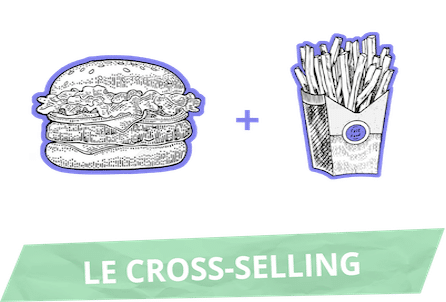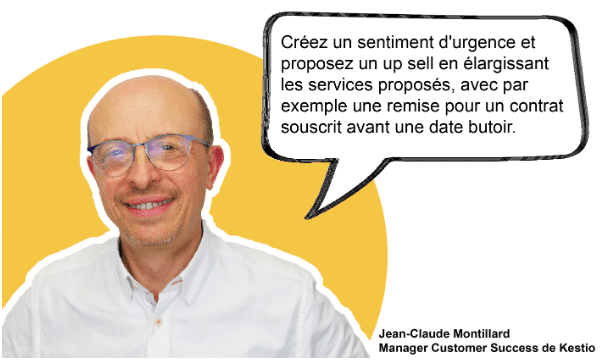35%.
Amazon generates 35% of its revenue through upselling!*
Cross-selling and up-selling can thus represent a real growth lever for your company, even if you are not a web giant!
*Source: The Future of Commerce
Cross-selling and up-selling, what is it?
Cross-selling is a sales technique that consists of offering a customer to buy products or services that complement those they have already purchased or are in the process of purchasing.
Up-selling is a sales technique that consists of offering a customer to buy a higher-end product or service (and therefore more expensive) than the one they initially intended to buy. |
Without even realizing it, you encounter these techniques every day! "And with this?" when you buy your baguette, "As a maxi best-of menu?" when you order your favorite hamburger...
However, cross-selling and up-selling are not only applicable to the B to C sector.
This sales strategy can be applied in B to B, regardless of the sector or size of your company.
Today, we will explain how to initiate this process within your organization. |
KEY #1 - Information Gathering
After several exchanges with your client, you often think you know them. You even sometimes know their next vacation destination!
But in reality, your client rarely shares more strategic information specific to the operation of their company. However, this type of information is necessary in a cross- and up-selling strategy.
You should therefore take advantage of already being in contact with your client to gather as much useful information for your sale as possible.
By collecting as much data as possible on your contact, their company, and their environment, you will identify their objectives and weaknesses preventing them from achieving their goal… and you can then demonstrate how your new offer could solve their problems!
This information gathering will help you create awareness in your client's mind: an awareness between what they are currently doing and what they could be doing, and therefore an awareness of new needs!
To do this, it is necessary to go beyond the simple functional need expressed by your contact.
Head towards the "Why?" of their action, challenge them!
You will then be able to question the initial plan conceived by your client in order to offer them a more suitable solution, and thus sell more and provide more value!
For example, for a professional training organization:
A Sales Director who uses Excel files for their customer relationship management will not necessarily be aware that their organization could be optimized. The current situation suits them!
It is by questioning them about their practices that you can suggest that training on a CRM tool will have a better ROI than simple Excel training. An awareness in their mind can thus be created!
To gather the most information about your contact and encourage them to question their habits and needs, various sales techniques and marketing tools exist.
At KESTIO, we particularly educate our clients on the art of questioning to spark awareness in their prospects. We also use various data enrichment tools to obtain relevant information during our interactions.
If you'd like to learn more about these methods and tools, we invite you to discuss this topic with us!
KEY #2 - Added value
The second key to promoting cross-selling and up-selling is to offer a perspective of added value that complements a service already accessible to the client. In other words, it is necessary to highlight the ROI by showcasing the potential gain.
Situational Exercise & Example
For example, if you offer a solution that solves a major problem, such as the time wasted by a manager manually distributing alerts, you can show how your solution can improve productivity, process, and overall results.
By giving concrete examples of how your solution can help solve your client's problems, you can convince them of the importance of your offer. Continuing with our example, you can explain how the solution's settings allow alerts to be automatically dispatched to people according to certain criteria, which leads to better customer satisfaction thanks to faster alert processing and better distribution of work among employees.
In summary, the key here is to show your client how your additional solution can bring real added value to their business, by enabling them to accomplish more, optimize their time, and better distribute their work.
We previously explained how to initiate this process during the webinar on Thursday, March 16th at 2 PM. This webinar focused on techniques to implement a cross- and up-selling strategy. Click the button below to review the webinar.
KEY #3 - Personalization
Adapt your speech to the profile of your interlocutor! It is important to understand that each customer is different and has specific needs. To be successful in selling effectively, it is essential to know the customer's personality profile in order to present the cross and up-sell from the right angle.
The advantage of cross-selling and up-selling is that you know your client better, you have had several meetings with them, and you potentially work with them. Therefore, you should leverage this knowledge of their profile and tailor your arguments by highlighting the most relevant points for the person in front of you.
For example, if we rely on the personality styles of the DISC model, which presents 4 main emotions through a composition of colors:
- D – Dominance
- I – Influence
- S – Stability
- C – Compliance
For example, the proposal of an automated prospecting service will differ depending on the profiles. For a blue profile, we will emphasize the improvement of the process; for a red profile, we will insist on better achievement of objectives; while for a green profile, we will highlight a better experience for the employees.
In addition to understanding the client's personality profile, it's important to continuously gather information to understand their organizational structure, their objectives, and any gaps your solution can fill. From a sales perspective, information is always key!
Ultimately, there are two levels to consider in order to sell effectively:
- What needs to be done to attract the customer's attention?
- Once they're interested, what do we need to do to tip the decision?
Want to learn more about the DISC model to tailor your communication to your audience's profile and better understand their thinking, feeling, and operating modes? Click the button below to watch our webinar on the DISC profile.









